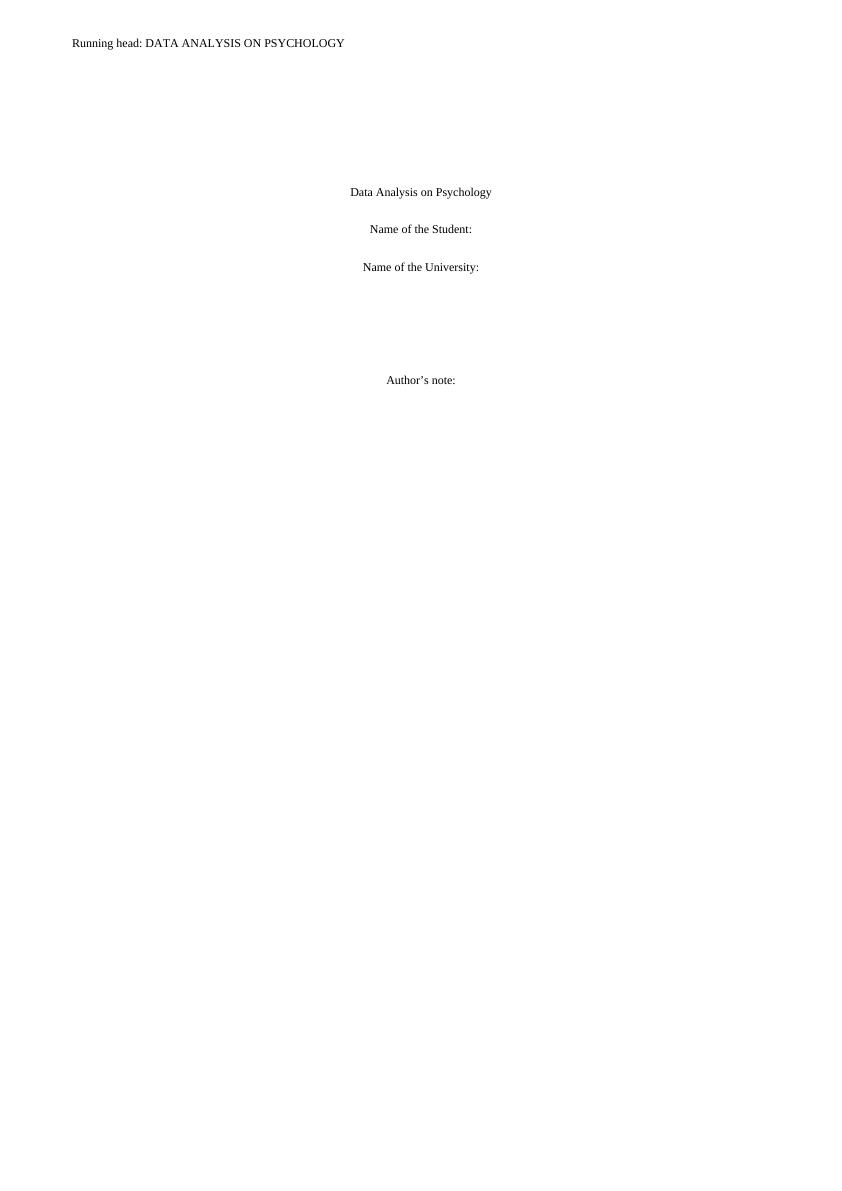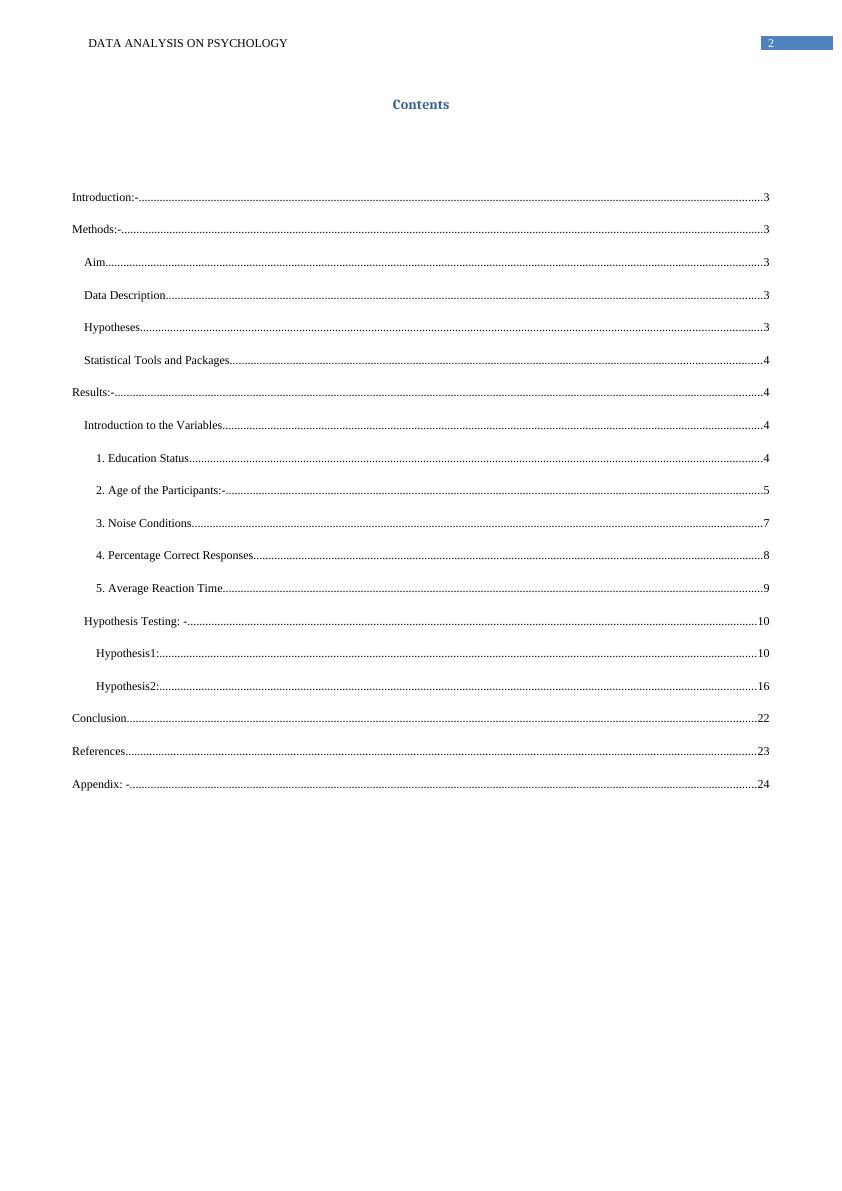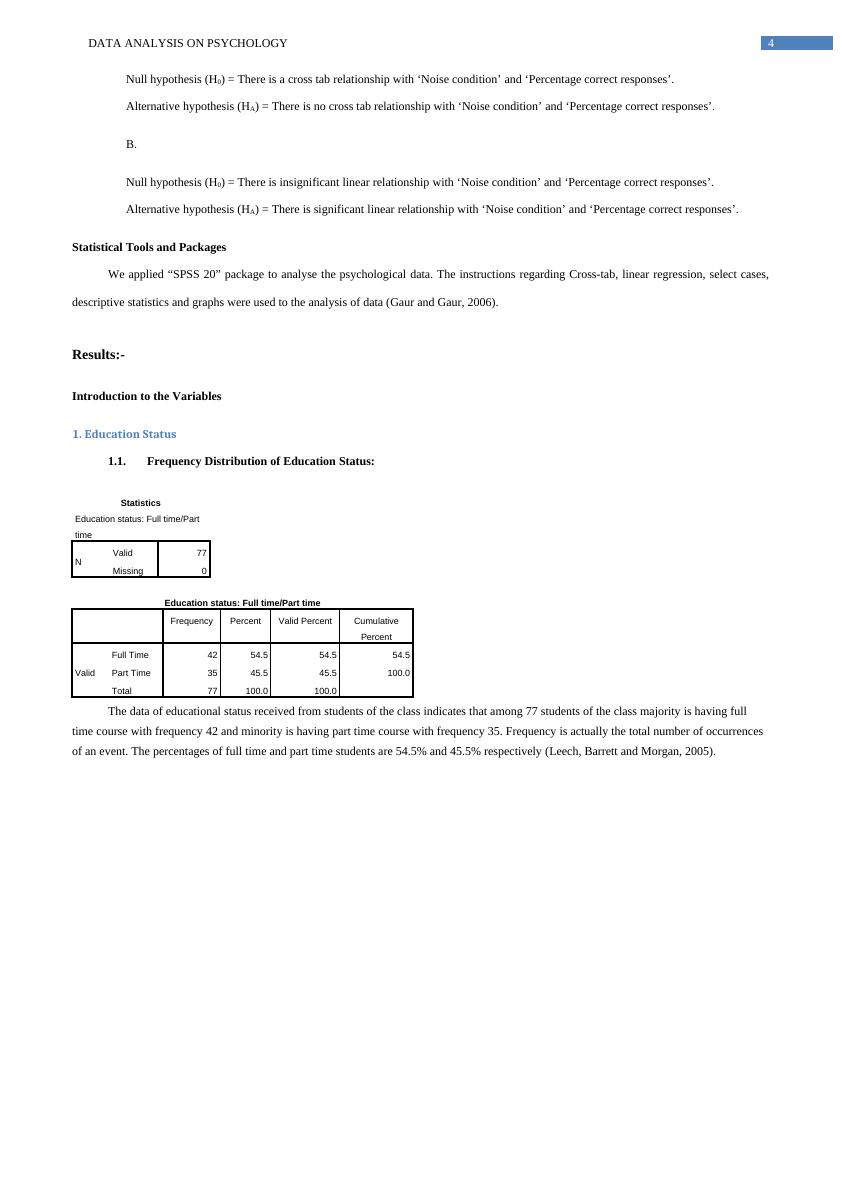Ask a question from expert
Data Analysis on Psychology - PDF
25 Pages6069 Words599 Views
Added on 2020-04-21
Data Analysis on Psychology - PDF
Added on 2020-04-21
BookmarkShareRelated Documents
Running head: DATA ANALYSIS ON PSYCHOLOGYData Analysis on PsychologyName of the Student:Name of the University:Author’s note:

1DATA ANALYSIS ON PSYCHOLOGYAbstractThe report incorporates a completion of a Lab Report supplemented by lecture material and additional material covered in the first semester ofclass in week 2. Lab Report is in Microsoft office (Excel) format. The Lab Report refers the discipline of psychology to the student forsystematically preparing a report in accordance with the applied scientific method. We ensure that all central variables are adequately defined.There are one main hypothesis common to all students to investigate, which is related to the differences between the three different ‘Noiseconditions’ (No noise/White Noise/Crowd Noise) on the ‘Response speeds’. We also tested one more hypothesis based on the additional datathat was collected different “Noise conditions” and “Percentage of correct responses”. Descriptive statistics, Correlation coefficient andnecessary graphs & plots were calculated and presented in the Lab Report of psychology class. The analysis is incorporated with the help ofSPSS 20.

2DATA ANALYSIS ON PSYCHOLOGYContentsIntroduction:-................................................................................................................................................................................................................3Methods:-......................................................................................................................................................................................................................3Aim...........................................................................................................................................................................................................................3Data Description.......................................................................................................................................................................................................3Hypotheses...............................................................................................................................................................................................................3Statistical Tools and Packages.................................................................................................................................................................................4Results:-........................................................................................................................................................................................................................4Introduction to the Variables....................................................................................................................................................................................41. Education Status...............................................................................................................................................................................................42. Age of the Participants:-...................................................................................................................................................................................53. Noise Conditions..............................................................................................................................................................................................74. Percentage Correct Responses..........................................................................................................................................................................85. Average Reaction Time....................................................................................................................................................................................9Hypothesis Testing: -..............................................................................................................................................................................................10Hypothesis1:.......................................................................................................................................................................................................10Hypothesis2:.......................................................................................................................................................................................................16Conclusion..................................................................................................................................................................................................................22References..................................................................................................................................................................................................................23Appendix: -.................................................................................................................................................................................................................24

3DATA ANALYSIS ON PSYCHOLOGYIntroduction:-In this study, participants were asked to select particular letters from an array of the letters. This case study welcomed participantsinto the Psychology Lab Room and the Lab Technician set the participant up with the experiment. Participants were given two practice trials andfeedback was given on how to correctly respond on the task if the participant needed. Each participant was given 15 test trials and the length oftime between the presentation of the task in each trial and the response on the keyboard was recorded. Participants also informed their age andeducation level. Participants were thanked for their involvement in the study and were instructed to return to their class. Later in the class,participants were debriefed and invited to ask questions about the experiment.The report concerns about the concerns regarding auditory distraction and the method how it affects performance in a cognitive attentiontask. The independent variable of the study was assigned to the auditory distraction group. Participants of study were assigned in three auditorygroups that are- 1) “White noise” group was given headphones and static white noise was played. 2) “Crowd noise” group was deliveredheadphones that played crowds talking similar to a busy cafe. 3) “No noise” group was assigned as controlled group where they were givenheadphones but nothing was played. Methods:-Aim The aim and objective of the study was to determine whether certain types of noise distraction would affect on the cognitive tasks likePercentage correct responses and average response times or not.Data DescriptionThe report describes about the collected data of classroom students. Total 77 students responded according to their background. The fivevariables are Education status, Age, Noise condition, Percentage correct responses (out of 15 test trials) and Average reaction times (out of 15test trials). Age, Percentage correct responses (out of 15 test trials) and Average reaction times (out of 15 test trials) are numeric in nature.Education status and Noise condition are categorical (nominal) in nature (Reynolds, 1984). We label “Full Time” as 1 and “Part Time” as 2.Next, we label “No Noise” as 1, “White Noise” as 2 and “Crowd Noise” as 3. We calculated the descriptive statistics of all the factors. Wecalculated cross function and linear regression relationship of Noise condition and Average reaction time out of 15 test trials. Then we calculatedcrosstab function and simple linear regression relationship of Noise condition and Percentage correct responses out of 15 test trials. Lastly, wecalculated correlation of ‘bivariate’ data between selected variables. HypothesesWe are eager to check mainly two hypotheses regarding the issue: 1)A.Null hypothesis (H0) = There is a cross tab relationship with ‘Noise condition’ and ‘Average reaction times’.Alternative hypothesis (HA) = There is no cross tab relationship with ‘Noise condition’ and ‘Average reaction times’.B.Null hypothesis (H0) = There is insignificant linear relationship with ‘Noise condition’ and ‘Average reaction times’.Alternative hypothesis (HA) = There is significant linear relationship with ‘Noise condition’ and ‘Average reaction times’.2)A.

4DATA ANALYSIS ON PSYCHOLOGYNull hypothesis (H0) = There is a cross tab relationship with ‘Noise condition’ and ‘Percentage correct responses’.Alternative hypothesis (HA) = There is no cross tab relationship with ‘Noise condition’ and ‘Percentage correct responses’.B.Null hypothesis (H0) = There is insignificant linear relationship with ‘Noise condition’ and ‘Percentage correct responses’.Alternative hypothesis (HA) = There is significant linear relationship with ‘Noise condition’ and ‘Percentage correct responses’.Statistical Tools and PackagesWe applied “SPSS 20” package to analyse the psychological data. The instructions regarding Cross-tab, linear regression, select cases,descriptive statistics and graphs were used to the analysis of data (Gaur and Gaur, 2006).Results:-Introduction to the Variables1. Education Status1.1.Frequency Distribution of Education Status:StatisticsEducation status: Full time/Part timeNValid77Missing0Education status: Full time/Part timeFrequencyPercentValid PercentCumulativePercentValidFull Time4254.554.554.5Part Time3545.545.5100.0Total77100.0100.0The data of educational status received from students of the class indicates that among 77 students of the class majority is having full time course with frequency 42 and minority is having part time course with frequency 35. Frequency is actually the total number of occurrences of an event. The percentages of full time and part time students are 54.5% and 45.5% respectively (Leech, Barrett and Morgan, 2005).

5DATA ANALYSIS ON PSYCHOLOGYThe Bar plot indicates the Full time and Part time Students’ frequency distribution in the class.1.2.Descriptive Statistics of Education Status:Descriptive StatisticsNRangeMinimumMaximumMeanStd. DeviationVarianceSkewnessKurtosisStatisticStatisticStatisticStatisticStatisticStatisticStatisticStatisticStd. ErrorStatisticStd. ErrorEducation status: Full time/Part time771121.45.501.251.186.274-2.018.541Valid N (listwise)77The descriptive statistics table of Education status indicates that mean, standard deviation and variance of the factorized categorical variable are 1.45, 0.501 and 0.251. We know that skewness is less than (-1) or greater than 1, is highly skewed. If the skewness is between (-1) and (-0.5) or between (0.5) to1, indicates a moderately skewed. If the skewness is between (-0.5) and (0.5), the distribution is approximately symmetric (Oja, 1983). The valueof skewness is 0.186. Therefore, we can conclude that the distribution is symmetric in nature.The value of Kurtosis greater than 3 indicates that the distribution is Leptokurtic (Peaked) (Judd, McClelland and Culhane, 1995). Thevalue of Kurtosis equal to 3 interprets that the distribution is perfectly normal. Lastly, the value of Kurtosis less than 3 indicates that thedistribution is Platykurtic (Flat). Here, value of Kurtosis is (-2.018). Hence, the data is platykurtic.2. Age of the Participants:-2.1. Frequency Distribution of Age:StatisticsAge of participantNValid77Missing0Age of participantFrequencyPercentValid PercentCumulativePercentValid19810.410.410.4201316.916.927.321810.410.437.72233.93.941.62333.93.945.5

End of preview
Want to access all the pages? Upload your documents or become a member.
Related Documents
Research theory design and methods PDFlg...
|10
|2196
|184
(PDF) Interpretation of Data in Psychologylg...
|10
|1635
|195
Psych 248 - Lab 10 Worksheet: Introduction to One-way ANOVAlg...
|4
|1496
|27
Research Report Presentationlg...
|19
|1293
|122